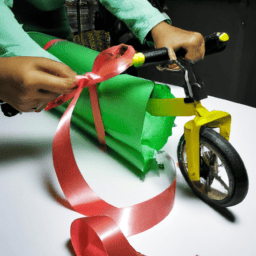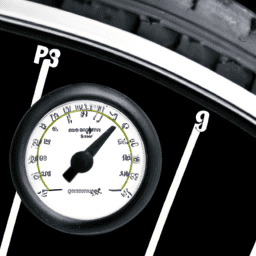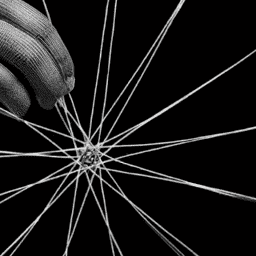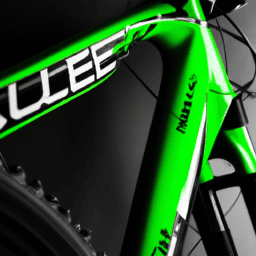In the realm of biking, keeping your tires in top condition is key to ensuring a seamless and secure journey. One of the core principles of tire upkeep involves precise measurement of the tire’s dimensions and pressure. A tire that is properly sized and filled offers improved grip, lessens rolling friction, and guards against flats. In this piece, I will walk you through the process of accurately measuring a bike tire.
Before we dive into measuring the tire, it is essential to gather the necessary tools. You will need a tape measure, a pump with a pressure gauge, and a pen and paper to note down the measurements.
Identifying your tire size is the first step to measuring your tire accurately. It can be challenging to determine the size of your tire as there are different types of tire sizes available. However, with the right tools and a little knowledge, it is easy to find out the size of your tire.
Key Takeaways
- Tire size can be identified by numbers and letters on the tire’s side, but a tire size chart or professional can help.
- Necessary tools for tire maintenance include a tape measure, pump with pressure gauge, and pen and paper.
- Checking tire wear and tear is important for preventing accidents and prolonging tire lifespan.
- Proper inflation improves handling, reduces rolling resistance, and increases tire longevity, while over-inflation causes stiff tires, harsh ride, and decreased traction, and under-inflation causes uneven tire wear and increased risk of pinch flats.
Gather Necessary Tools
Before you can start measuring your bike tire, you’ll need to gather all the necessary tools. Tool recommendations include a tire gauge and a pump, which are essential for accurately measuring the tire pressure.
The tire gauge allows you to check the pressure level of your bike tire, while the pump can be used to inflate or deflate the tire to the recommended pressure level. Proper handling of the tools is also important to ensure accurate measurement.
When using the tire gauge, make sure to firmly attach it to the valve stem and hold it steady until the reading stabilizes. When using the pump, avoid over-inflating the tire, and only inflate it to the recommended pressure level as indicated on the tire or in the bike owner’s manual.
Once you have gathered the necessary tools and know how to handle them properly, you can move on to identifying your tire size.
Identify Your Tire Size
When you hop on your two-wheeled ride, take note of the numbers engraved on the side of your trusty rubber companion. These numbers indicate the size of your tire, which is crucial information when it comes to replacing or upgrading your tires.
However, tire sizes can be confusing, especially for beginners. The good news is that it’s easy to understand tire markings once you know what to look for.
First, you need to understand that tire sizes are represented by a combination of numbers and letters. The most common format is a series of three numbers followed by a slash and another two numbers. For example, a tire size of 700x25c means that the tire has a diameter of 700mm and a width of 25mm. However, some tires may have a different format or use a different unit of measurement, such as inches or French sizes.
Converting tire sizes can be tricky, so it’s important to consult a tire size chart or ask a professional if you’re not sure.
Once you’ve identified your tire size, you’re ready to measure your tire and make sure it’s the right fit for your bike.
Measure Your Tire
Now that I know my tire size, it’s important to determine the correct pressure for my bike tires. This ensures that I have the right amount of air in my tires for optimal performance and safety.
Additionally, regularly checking for wear and tear on my tires is crucial in preventing potential accidents and prolonging the lifespan of my tires.
Determining the Correct Pressure
Achieving optimal performance and a smooth ride on your bicycle requires knowing the correct pressure for your tires. The importance of pressure cannot be overstated since it affects the stability, grip, and maneuverability of your bike.
Riding with underinflated tires can cause drag and make pedaling more difficult, while overinflated tires can make the ride bumpy and uncomfortable. Therefore, it’s essential to determine the correct tire pressure and maintain it regularly.
To determine the correct pressure, you need to find the recommended range indicated on the sidewall of your tire. It’s usually expressed in pounds per square inch (PSI) or bars. Once you have the range, you can use a pressure gauge to measure the current pressure in your tires and adjust it as necessary.
To do so, you’ll need to use a pump that can inflate your tires to the recommended pressure. Choosing the right pump is crucial since different types of valves require different fittings. You can find pumps with adapters for Presta and Schrader valves, which are the most common types used in bicycles.
By maintaining the correct tire pressure, you can ensure a safe and comfortable ride. Checking for wear and tear is also important to keep your bike in good condition and avoid unexpected breakdowns.
Checking for Wear and Tear
As a savvy rider, you know that keeping your bike in top shape is crucial to avoid unexpected breakdowns and maintain optimal performance. So, it’s important to regularly inspect for signs of wear and tear.
There are several causes of wear and tear on your bicycle tires, including overuse, underinflation, and poor road conditions. To ensure your tires are in good condition, check for cuts, bulges, or cracks on the sidewall and tread. Additionally, inspect the tire’s wear indicators, which are small rubber bumps located in the tread grooves. If these bumps are no longer visible, it’s time to replace the tire.
If you do discover wear or damage on your tire, there are repair options available. For minor cuts or punctures, a tire patch kit can be used to fix the issue. However, if the tire is severely damaged or worn, it’s best to replace it entirely.
Remember that riding on worn or damaged tires can lead to decreased performance, increased risk of flats, and even accidents. By regularly checking for wear and tear, you can ensure your tires are in top condition and avoid any unexpected mishaps on your rides.
As you move on to the next section about inflating your tires, keep in mind that proper inflation is crucial for maintaining your tires’ performance and lifespan.
Inflate Your Tires
Make sure you’re inflating your bike tires to the appropriate pressure to ensure a smooth and efficient ride. Proper inflation has numerous benefits, including improved handling, reduced rolling resistance, and increased longevity of the tire. Choosing the right valve for your tire is also important. Common valve types include Presta and Schrader, with Presta valves being more common on road bikes and Schrader valves on mountain bikes.
To determine the appropriate tire pressure, refer to the sidewall of your tire, which should list the recommended minimum and maximum pressures. Use a tire gauge to measure the pressure and add or release air as needed. Over-inflation can cause the tire to become too stiff, leading to a harsh ride and decreased traction, while under-inflation can cause the tire to wear unevenly and increase the risk of pinch flats. By maintaining proper inflation, you’ll ensure a more comfortable and safe ride.
Maintaining your tires is an important aspect of bike maintenance, and proper inflation is just one part of it.
Maintain Your Tires
As a cyclist, I need to maintain my tires for optimal performance and safety. Regular checks are crucial to ensure proper inflation, tread wear, and to identify any punctures or damages. It is also important to store tires properly to avoid damage from exposure to sunlight, heat, and moisture.
By following these guidelines, I can ensure that my tires are always in top condition. This will provide a smooth and safe ride every time.
Regular Checks
Take a moment to feel the smooth rubber of your bike tire and check for any cracks or bulges that may have developed over time. Regular checks of your bike tire are crucial to ensure that it’s in optimal shape for riding.
Here are some tips for accurate measurements and the importance of frequency when checking your bike tire:
- Use a tire gauge to measure the pressure of the tire. The pressure should match the recommended range printed on the tire sidewall.
- Check the tread depth regularly. The tread should be deep enough to provide adequate traction on wet or slippery surfaces.
- Inspect the tire for any punctures or cuts that may have occurred during use. These can weaken the tire and increase the risk of a blowout.
- Rotate the tires periodically to ensure even wear and prolong their lifespan.
Regular checks of your bike tire can help prevent accidents and prolong the life of your tire. In addition to proper maintenance, proper storage can also contribute to the longevity of your tire.
Proper Storage
Ensuring your bike’s tires are stored properly can make all the difference in their lifespan and keep you rolling safely and smoothly. Before storing your bike, it’s important to clean it thoroughly, including the tires, to remove any dirt or debris that could cause damage.
Once cleaned, make sure the tires are inflated to the recommended pressure to prevent flat spots from forming while in storage.
When it comes to storing your bike, there are a few tips that can help protect your tires. Firstly, avoid storing your bike in direct sunlight or extreme temperatures, as this can cause the rubber to degrade. Secondly, if possible, store your bike indoors or in a covered area to protect it from the elements. Lastly, consider using tire covers or placing a piece of cardboard underneath the tires to prevent them from touching the ground and picking up any debris.
By following these maintenance techniques and storing tips, you can help extend the lifespan of your bike’s tires and keep your rides smooth and safe.
Frequently Asked Questions
How often should I replace my bicycle tires?
My bicycle tires are the foundation of my ride, and like any foundation, they need to be sturdy. Signs of tire wear and factors affecting tire lifespan vary, but proper storage and maintenance can prolong their life.
What is the ideal tire pressure for my bicycle tires?
The ideal tire pressure for my bicycle tires is crucial for optimal performance. Low tire pressure results in sluggish rides, while high pressure leads to discomfort and reduced grip. Maintaining consistent pressure is key for safety and efficiency on the road.
Can I use a measuring tape to measure my bicycle tire?
Honestly, measuring a bicycle tire with a measuring tape can be problematic. Measuring tape alternatives, such as a caliper or ruler, are more reliable. Common tire measurement mistakes include not accounting for tire bulge and inaccurate measurements due to tire compression.
What are the different types of bicycle tires and how do I choose the right one for my bike?
When choosing bicycle tires, I consider factors like terrain, weather, and riding style. I weigh the pros and cons of tube vs. tubeless tires, looking at factors like comfort, puncture resistance, and ease of repair.
Is it necessary to use a specific brand of tire gauge to measure my bicycle tire pressure accurately?
Using a digital tire gauge can improve accuracy by up to 0.5 psi compared to analog gauges. Temperature can also affect tire pressure readings, so it’s important to measure when the tire is at a consistent temperature. Brand doesn’t matter as long as the gauge is accurate and calibrated.
Conclusion
In conclusion, measuring your bicycle tire is an essential aspect of maintaining your bike. With the right tools and techniques, you can easily determine your tire size, and ensure that it’s inflated to the correct pressure.
Don’t underestimate the importance of tire maintenance! Neglecting your tires can lead to poor performance, uncomfortable rides, and even accidents. By measuring and maintaining your tires, you can extend the life of your bike and enjoy smoother, more efficient rides.
So, grab your measuring tape and pump, and get to work! Your bike (and your body) will thank you.









